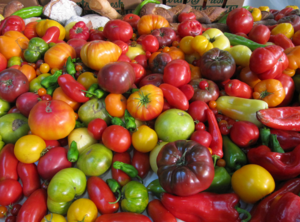
Heirloom vegetables are the varieties of vegetables that were available prior to the major onset of monoculture approaches to producing vegetable crops, mostly prior to WWII. They are vegetables handed down the generations of families and local communities. They are unique, individual, often very different from their monoculture, standardised cousins. They may have different colours, shapes, sizes and even textures, all depending on what has been favoured for keeping and passing on over the decades and centuries. To the eyes of some people, they may appear misshapen or imperfect in some respects but that is deceptive, as they are tasty, nutritious and enjoyable.
The diversity arises from the fact that these vegetables have been treasured within many different groups of people across wide areas, allowing varieties to diverge and still thrive across the planet. This diversity is important not just for providing interesting variety for the dinner table but also for the ability of food crops to thrive and defeat plant diseases and pests that can devastate monocultures.
Heirloom vegetables often have meaning for those who save and grow their seeds. There may be familial, cultural and regional meanings attached to the heirloom vegetables.